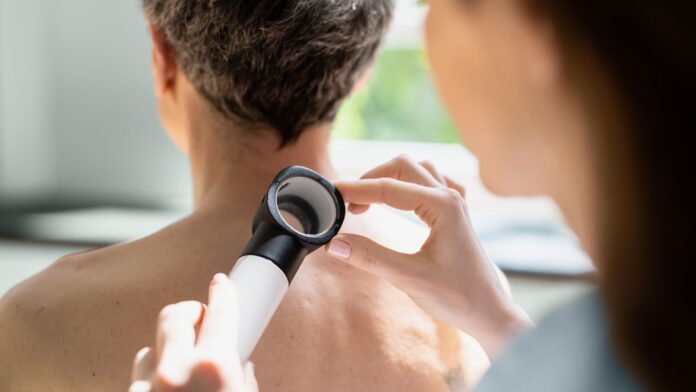Scientists are working to harness the power of the herpesvirus responsible for cold sores in order to treat a deadly cancer: late-stage melanoma.
About half of people with this advanced form of skin cancer run out of viable treatment options, says Gino In, MD, MPH, a coauthor of the study and an associate professor and oncologist with Keck Medicine of USC in Los Angeles.
Melanoma Deaths Are Down, but Some Cases Remain Stubbornly Resistant to Treatment
Skin cancer is the most common type of cancer in the United States, with melanoma accounting for about 1 in 100 cases. Although melanoma is rarer than other skin cancers, it causes a large majority of skin cancer deaths.
That’s what makes the new clinical trial results so encouraging.
“The concept of just a few injections into the patients’ tumors leading to long-lasting control of their cancer throughout the body is a powerful testimony to the power of our immune system in eradicating cancer cells, with minimal side effects,” says Shailender Bhatia, MD, the director of the melanoma and renal cancer team at the Fred Hutch Cancer Center and a professor of medical oncology at UW Medicine in Seattle. Dr. Bhatia wasn’t involved in this trial.
How to Turn a Virus Into a Cancer Fighter
The genetically modified virus, known as RP1, is a version of the herpes simplex virus type 1 (HSV-1) — the same one responsible for cold sores.
In its natural state, this herples simplex virus infects skin and nerve cells, often lying dormant after an initial outbreak. But researchers engineered RP1 to strip away its ability to cause disease, then supercharged its anti-cancer potential. That involved removing genes that cause illness in humans, while enhancing genes that help kill cancer and stimulate the immune system, says Dr. In.
The team deleted genes in HSV-1 that allow the virus to enter normal cells, he explains. “In addition, normal healthy cells also have the ability to fight off viruses through the immune system, whereas cancer cells are not as adept at avoiding virus infection this way. Together, these can both help RP1 preferentially attack cancer cells alone, but not normal healthy cells,” says In.
RP1 Treatment Shrank Tumors in One-Third of Patients
Researchers enrolled 140 people with advanced melanoma that had continued to grow despite standard immunotherapy.
Participants were given injections of RP1 directly into their tumors every two weeks for up to eight doses, combined with intravenous nivolumab.
“Unlike other cancer drugs, RP1 is injected into a melanoma tumor, whether located on the skin, in the lymph nodes, or even if there is a tumor in one of the organs, such as the lungs or liver,” says In.
Investigators found that not only did the injected tumors shrink in 1 out of every 3 participants by 30 percent — but additional tumors that didn’t get injected with RP1 also shrank or even disappeared just as frequently and as deeply.
Unreachable Tumors Also Shrank — or Even Disappeared
That finding suggests that RP1 is effective in targeting cancer throughout the entire body and not just the injected tumor, says In. “That expands the potential effectiveness of the drug because some tumors may be more difficult or impossible to reach,” he says.
Amanda Kirane, MD, PhD, the director of cutaneous surgical oncology at Stanford Cancer Center in California, agrees, calling the data “very exciting” for people with late-stage melanoma, and also for future treatments of tumors affecting internal organs that can’t be reached by injection. Dr. Kirane was not involved in the development or trial of the new treatment.
The results of this treatment in melanoma are likely to lead to similar success in other cancers, adds Bhatia.
RP1 treatment was well-tolerated, with most side effects limited to mild cold- or flu-like symptoms.
How Does a 1 in 3 Response Rate Compare With Other Treatments?
“The one-third response rate is pretty good, considering other available options,” says In. “There is a new type of treatment called TIL therapy, which also has similar response rates, but which carries considerable side effects and is given in the hospital only because it requires close monitoring,” he says.
Another combination, which uses nivolumab with the monoclonal antibody relatlimab, is much safer, but has a response rate of closer to 1 in 6, says In. “So considering the low side effect profile and lack of much better options, one-third for RP1 is viewed as being quite favorable,” he says.
Bhatia agrees that the RP1 response rate compares well to other existing therapies, but “distinguishes itself in having minimal risk of serious systemic side-effects.”
It’s too soon to tell if the positive outcomes will remain permanent, but the authors are optimistic about the future of RP1 therapy, and have already begun a phase 3 trial, called IGNYTE-3, to confirm their findings in a larger group of people.
When Will the Treatment Become Available?
RP1 used together with nivolumab is currently under priority review by the U.S. Food and Drug Administration, and a decision on potential accelerated approval is expected as early as July 2025, says In.
“I would stay tuned to see what happens with this. With so few other drugs being used in melanoma, this new approval could change how we treat this cancer quite dramatically,” he says.
In the meantime, patients may be eligible to enroll in the phase 3 trial, which will be held across 41 sites. If you or someone you know is living with advanced melanoma and is interested, talk to your doctor about clinical trial options or visit the trial’s page on ClinicalTrials.gov.

